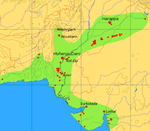History
Main article: History of Sind] Ancient history
Sindh's first known village settlements date as far back as 7000 BCE. Permanent settlements at Mehrgarh to the west expanded into Sindh. This culture blossomed over several millennia and gave rise to the Indus Valley Civilization around 3000 BCE. The Indus Valley Civilization rivaled the contemporary civilizations of Ancient Egypt and Mesopotamia in both size and scope numbering nearly half a million inhabitants at its height with well-planned grid cities and sewer systems.Sindh was conquered by the Persian Achaemenid Empire in the sixth century BC. In the late 300s BC, Sindh was conquered by a mixed army led by Macedonian Greeks under Alexander the Great. The region remained under control of Greek satraps only for a few decades. After Alexander's death, there was a brief period of Seleucid rule, before Sindh was traded to the Mauryan Empire led by Chandragupta in 305 BC. During the rule of the Mauryan Emperor Ashoka, the Buddhist religion spread to Sindh.
Mauryan rule ended in 185 BC with the overthrow of the last king by the Sunga Dynasty. In the disorders that followed, Greek rule returned when Demetrius I of Bactria led a Greco-Bactrian invasion of India and annexed most of northwestern lands, including Sindh. Demetrius was later defeated and killed by a usurper, but his descendants continued to rule Sindh and other lands as the Indo-Greek Kingdom. Under the reign of Menander I many Indo-Greeks followed his example and converted to Buddhism.

No comments:
Post a Comment